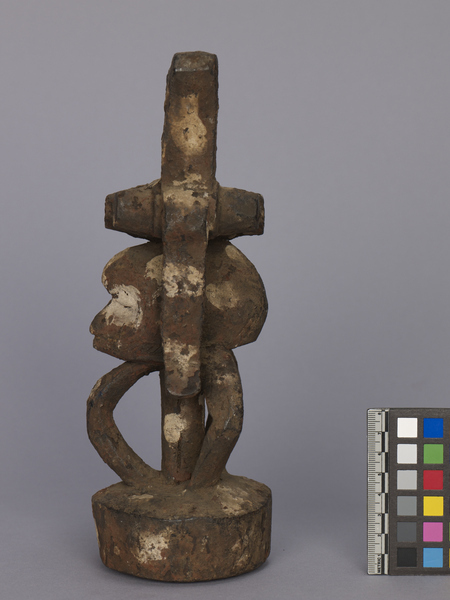Figure Item Number: 3055/14 from the MOA: University of British Columbia




Description
Carved wooden ikenga figure resting on a round base. Head is perched on a stylized pillar consisting of 3 thin bars. Straight central pillar is surrounded by 1 rounded pillar and 2 triangular ones. Oval head is minimally carved with protruding forehead, nose, and chin. A carved garland decorates both sides of chin. Short intricate headdress constructed from a thin main bar decorated with 2 half crescents carved with diagonal lines on top, and 2 curved bands carved with horizontal lines hanging below. 3 small round bolts protrude from the front and back of the main bar.
History Of Use
Ikenga (literally "strength of movement") is a horned spirit and one of the most powerful symbols for the Igbo people. Smaller figures were owned by individual men; larger ones were made for family and village shrines. Although taking on different forms, the figures always have a pair of ram’s horns, representing the animal’s strength and fortitude, characteristics like power, achievement and upward mobility, valued by men who regularly invoke them for success. Ikenga rarely stand alone; they appear on altars alongside other objects dedicated to chi or ndimmo (ancestors). This acknowledges achievements of individuals, as well as relationships with family and the creator. To affirm these relationships, the ensembles are given joint offerings. When ikenga do stand alone, sometimes in the sleeping quarters of their owners, the offerings they are given only acknowledge success in personal undertakings, such as hunting or trading expeditions. Annual feasts dedicated to ikenga provide further opportunity for the evaluation of personal achievement.
Item History
- Made in Nigeria
- Owned by Alan R. Sawyer before 2002
- Owned by Erika H. Sawyer before April 16, 2014
- Received from Erika H. Sawyer (Seller) and Museum of Anthropology Acquisitions Budget (Funding source) on April 16, 2014
What
Who
- Culture
- Igbo
- Previous Owner
- Alan R. Sawyer and Erika H. Sawyer
- Received from
- Erika H. Sawyer (Seller) and Museum of Anthropology Acquisitions Budget (Funding source)
Where
- Holding Institution
- MOA: University of British Columbia
- Made in
- Nigeria
When
- Ownership Date
- before 2002 and before April 16, 2014
- Acquisition Date
- on April 16, 2014
Other
- Item Classes
- carvings & sculpture
- Condition
- fair
- Accession Number
- 3055/0014